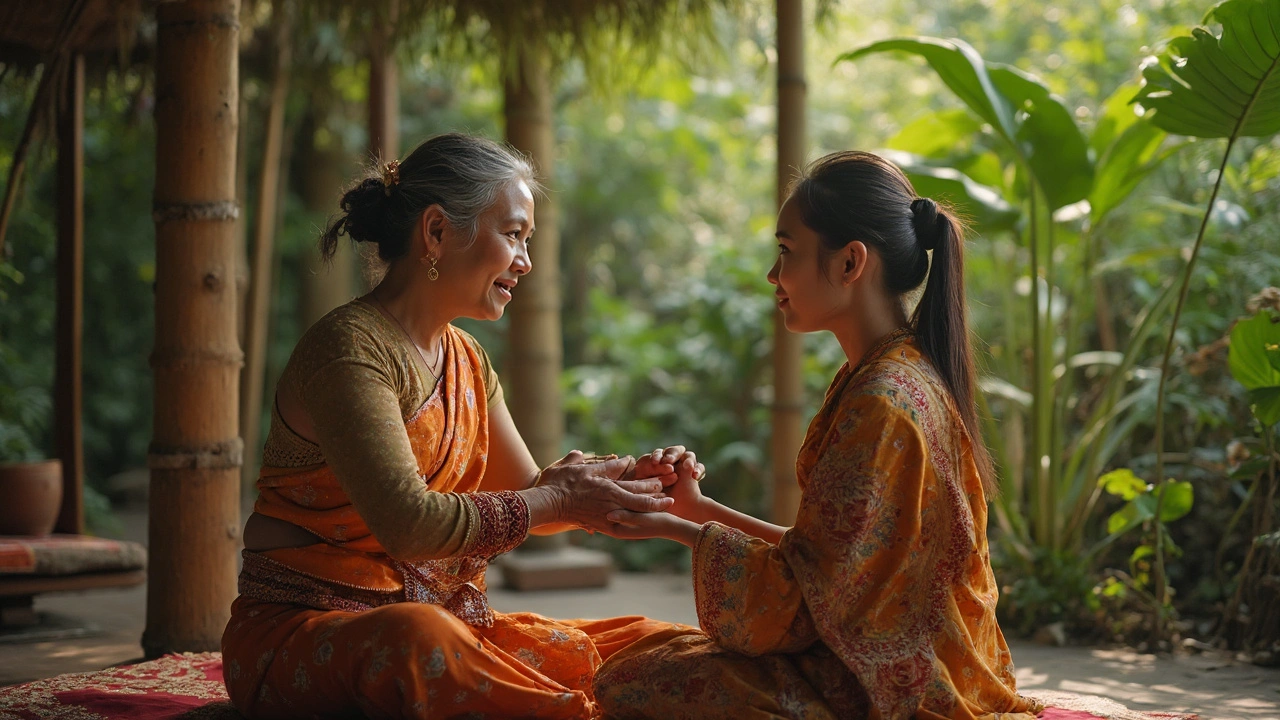Suffering from chronic pain and wondering if there's another way to manage it beyond the usual meds and physiotherapy? Thai massage might just be the game-changer you've been looking for. Unlike traditional massages that focus on muscle relaxation, Thai massage involves deep stretching and pressure point therapy to release tension and promote healing.
Picture this: your therapist uses not just their hands, but elbows, knees, and even feet to stretch and knead your muscles. Sounds intense? It can be, but for many, it's exactly what they need to loosen up knotted muscles and soothe their aches. No oil or fancy techniques—just pure, focused muscle work.
Wondering why this works? Well, it's all about balance. Thai massage focuses on the body's energy lines, similar to acupuncture points, to restore the flow of life energy. This can help reduce pain and improve flexibility, which is essential for those living with chronic discomfort.
- Overview of Thai Massage
- Benefits for Chronic Pain
- Different Techniques Explained
- Finding the Right Therapist
- Tips for Your First Session
Overview of Thai Massage
Thai massage isn’t your typical lay-down-and-relax type of session. It’s a unique blend of acupressure, Indian Ayurvedic principles, and yoga postures. Recognized for its healing benefits, it's believed to date back over 2,500 years to ancient India and was passed down through Buddhist monks. The practice eventually made its way to Thailand, where it was further developed and became a staple in Thai culture.
The practice revolves around the concept of energy lines or 'Sen' that run throughout the body. Practitioners of Thai massage believe stimulating these energy lines helps restore balance, improves flexibility, and enhances the body’s natural energy flow, all of which are crucial for chronic pain relief.
What Sets Thai Massage Apart?
Unlike most Western massage techniques, Thai massage takes place fully clothed. There's no oil used, and it is typically done on a mat on the floor. This allows the therapist to use their body weight effectively, leveraging not just hands but also elbows, knees, and feet to manipulate the client’s body into various positions. Imagine it as a kind of assisted yoga where you’re more of a passive participant.
The session can range anywhere from an hour to two hours, depending on the focus needed. It's interactive, requiring the therapist and the receiver to work together in a rhythmic dance of push and stretch. It may sound a bit intense, but many find it powerfully calming and invigorating.
- Usually performed on a mat, no oils used
- Incorporates stretching, pulling, and rocking techniques
- Helps improve flexibility, circulation, and energy levels
Overall, the method is known for leaving people feeling relaxed yet energized—imagine feeling like you’ve just had a workout, but without the sweating!
Benefits for Chronic Pain
If you're dealing with chronic pain, incorporating Thai massage into your routine could be a game-changer. First off, let's talk about pain relief. The mix of deep tissue work and stretching in Thai massage helps release muscle tension, and this is crucial for chronic sufferers.
Improved Flexibility
Each session of Thai massage involves yoga-like stretches that are designed to increase your range of motion. Over time, this can lead to improved flexibility, making daily movements less painful. Imagine being able to lift your arms without that familiar twinge or bend without wincing!
Better Blood Circulation
Let's not forget the boost in circulation. Thai massage techniques stimulate blood flow, which helps to deliver oxygen and nutrients to sore, aching muscles. Better circulation means quicker recovery, reducing stiffness and pain in the long run.
Reduced Stress
Chronic pain often comes with stress and anxiety. Engaging in regular Thai massage can help lower these stress levels. The gentle pressure and rhythmic strokes promote relaxation and reduce the production of stress hormones, letting your mind and body unwind. Who doesn't need a bit more zen in their life?
Holistic Healing
This massage form treats the body as a whole, addressing pain but also aiming for balance across your physical and emotional health. Think of it like rebooting your system—it's not just pain relief, it's holistic healing.
Real-Life Impact
According to a 2023 study in the Journal of Pain Management, individuals receiving regular Thai massage reported a 30% reduction in chronic pain levels compared to other therapies. Those are the kinds of stats that make you sit up and listen, right?

Different Techniques Explained
Diving into the world of Thai massage, you might be surprised by how many unique techniques are wrapped into this ancient practice. Each aims to tackle pain management and boost overall wellness.
Stretching
Think of this as yoga, but you're not doing any of the work. The therapist will use their body to help stretch yours in various positions. These stretches target tight muscles and work to improve flexibility. It's great for chronic pain relief since it gently eases tension that's built up over time.
Pressure Points
Thai massage focuses heavily on acupressure points, which are similar to the ones used in acupuncture. By applying pressure with thumbs, palms, or even elbows, the therapist can relieve pain and improve circulation. It's all about opening up the body’s blocked pathways and allowing energy to flow freely, which is key in reducing pain.
Joint Mobilization
This involves using movements to improve the range and ease of your joint motion. It's particularly helpful for those with stiff joints due to arthritis or repetitive stress injuries. Increased joint mobility can lead to a decrease in pain and better movement overall.
Rhythmic Compression
In this technique, the therapist applies gentle, rhythmic pressure to different parts of your body. It helps in relaxing muscles and enhancing blood flow, essential for healing and pain reduction.
Energy Line Therapy
Thai massage practitioners often focus on ten energy lines called 'Sen.' Working on these lines is thought to balance the body’s energy and influence both physical and mental health. Clearing blockages along these lines is believed to relieve tension and pain.
Everyone's experience will be a bit different, as therapists might combine various techniques based on what you need. Whether you're new to massage or an old pro, understanding these techniques can help you get the most out of your next session.
Finding the Right Therapist
Choosing the right therapist can make all the difference when you're looking to ease chronic pain with Thai massage. It’s not just about finding someone close by, but someone who truly understands your needs.
Do Your Homework
You'd be surprised how much easier it is to pick the right person when you know what to look for. Start by checking out their certifications and training. In the U.S., look for therapists certified by a recognized body like the Thai Healing Alliance International (THAI). This ensures they have the right knowledge and skills.
Therapists usually have reviews online. Be sure to read through them on platforms like Yelp or Google Reviews. They can give you a sense of other clients' experiences and what you can expect.
Ask Questions
Before booking, don’t hesitate to ask questions. A good therapist will be happy to discuss their process, experience, and how they can help with your specific pain issues. Remember, it's your body, and your comfort is a priority.
Trial Session
If possible, try a trial session before committing to a package. This can help you gauge how comfortable you feel with their approach and whether their style suits your needs. Even a short session can give you a lot of insights.
“A skilled Thai yoga massage therapist doesn't just perform a service; they walk with you through your healing journey,” says Nancy Ava, a veteran therapist with over 20 years in the field.
Look for Specialties
Some therapists specialize in certain conditions. If they have experience with pain management, it’s a huge plus. Therapists often list their specialties on their websites or business profiles, making it easier for you to decide.
| Factor | Importance |
|---|---|
| Certification | Essential |
| Client Reviews | Helpful |
| Specialties | Valuable |
Treat each session as a learning experience—what helps, what doesn't—and communicate regularly with your therapist. Remember, finding the right massage therapy is part science, part art. Trust your instincts, and don’t be afraid to try someone new if things aren't working out.

Tips for Your First Session
Heading to your first Thai massage session? Exciting! But if you're feeling a bit unsure about what to expect, don't worry—I've got you covered. Here's a handy guide to help you make the most of this unique experience.
What to Wear
Unlike oil-based massages where you might be fully undressed, Thai massage usually requires you to wear loose, comfortable clothing. It's all about mobility, so think yoga pants or a comfy tracksuit.
Communicate with Your Therapist
Before the session kicks off, have a chat with your therapist. Let them know about any specific areas of chronic pain you're dealing with. This ensures they tailor the session to your needs and avoid any discomfort.
Embrace the Stretch
Thai massage involves a lot of stretching—kind of like assisted yoga. Don’t be surprised if your therapist uses their entire body to help stretch and flex your limbs. Just breathe and relax into it.
Hydrate Before and After
Hydration is key. Drink water before your session and down a glass or two after. This helps flush out any toxins released during the massage, keeping those muscles happy and healthy.
Set Realistic Expectations
It's worth noting that while many people find immediate pain relief, others experience soreness before feeling better. Think of it like a good workout—that delightful post-exercise sore feeling where you know progress is happening underneath.
By following these simple tips, your first session should be smooth sailing. Enjoy your journey to better health and easier movement with Thai massage!




